Background
Previously we described our Android Infrastructure Setup and we will now look at some key areas of our sample’s code. See also the Client Side API Journey to understand the background and the requirements being met.
Goal: Portable Coding Model
One of this blog’s coding goals is to use the same UI classes across multiple platforms. Our Android App uses the same logical separation of responsibilities into classes as the earlier React SPA:

Goal: Unobtrusive OAuth Integration
The fragment classes show below call our OAuth Secured API, and need to deal with triggering login redirects and renewing tokens. This can also involve concurrency, which we will explore shortly.
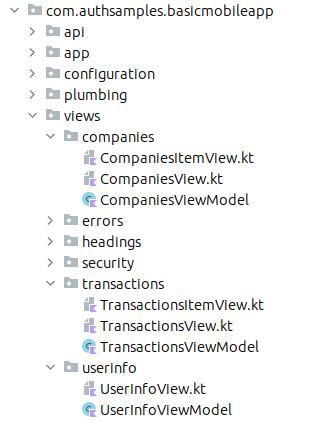
Companies will want to complete this tricky plumbing code once, then focus on business value, by growing the UI and API code.
Project Creation
The project was initially created via the below Empty Activity template, after which I began developing layout files and Kotlin classes:
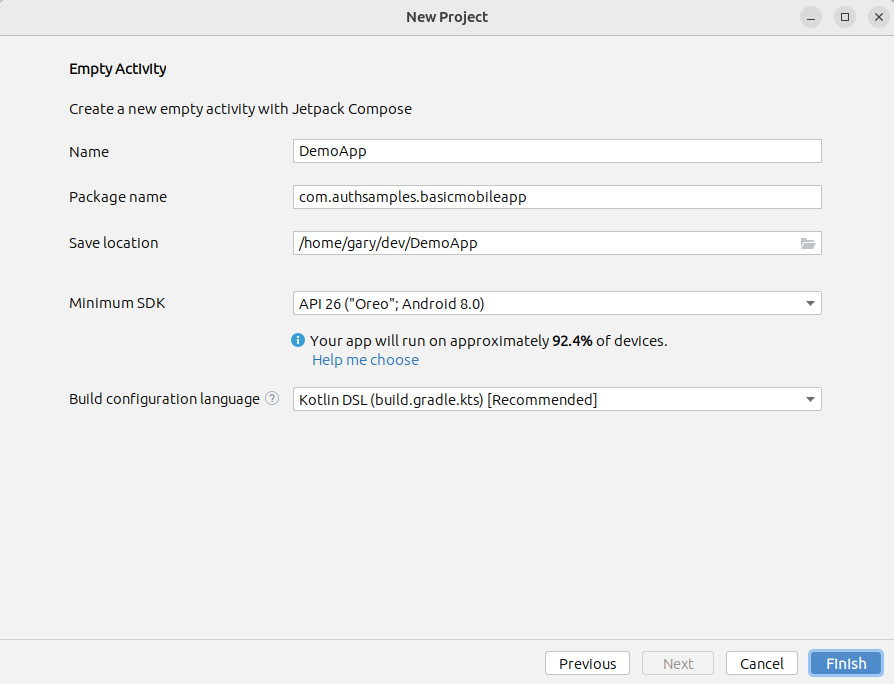
I then added these options to the application’s build.gradle.kts file, which enables views to be created using the newer Jetpack Compose syntax, which lead to simpler code than older XML layout views:
buildFeatures {
compose = true
}
composeOptions {
kotlinCompilerExtensionVersion = "1.5.3"
}Main Activity Entry Point
Our single activity is specified in the manifest file as the default / launcher activity, and fulfils a similar role to our SPA’s application shell:
<activity
android:name=".app.MainActivity"
android:exported="true"
android:launchMode="singleTop"
android:configChanges="orientation|screenSize">
<intent-filter>
<action android:name="android.intent.action.MAIN"/>
<category android:name="android.intent.category.LAUNCHER"/>
</intent-filter>
</activity>Our code begins in the onCreate override, which initialises the main view model and creates views:
override fun onCreate(savedInstanceState: Bundle?) {
super.onCreate(savedInstanceState)
(this.application as Application).setMainActivity(this)
actionBar?.hide()
val model: MainActivityViewModel by viewModels()
this.model = model
this.createViews()
this.model.initialize(this::onLoaded)
}
private fun onLoaded() {
this.binding.model!!.eventBus.register(this)
this.navigateStart()
}Views can be recreated at any time, whereas the main view model is only created once. When it is constructed it reads settings from the JSON configuration file embedded in the app, then creates global objects used for OAuth and API operations:
init {
this.configuration = ConfigurationLoader().load(this.app.applicationContext)
this.fetchCache = FetchCache()
this.eventBus = EventBus.getDefault()
this.authenticator = AuthenticatorImpl(this.configuration.oauth, this.app.applicationContext)
this.fetchClient = FetchClient(this.configuration, this.fetchCache, this.authenticator)
this.viewModelCoordinator = ViewModelCoordinator(this.eventBus, this.fetchCache, this.authenticator)
this.isLoaded = false
this.isTopMost = true
this.isDeviceSecured = DeviceSecurity.isDeviceSecured(this.app.applicationContext)
}View Layout and Composition
The main activity’s layout creates a number of child views, including a navigation host, whose content is swapped out as the user navigates, in a similar way to the main view of an SPA:
private fun createViews() {
val that = this@MainActivity
setContent {
ApplicationTheme {
Column {
TitleView(that.model.getUserInfoViewModel())
HeaderButtonsView(
that.model.eventBus,
that::onHome,
that::onReloadData,
that::onExpireAccessToken,
that::onExpireRefreshToken,
that::onStartLogout
)
if (model.error.value != null) {
ErrorSummaryView(
ErrorViewModel(
model.error.value!!,
stringResource(R.string.main_error_hyperlink),
stringResource(R.string.main_error_dialogtitle)
),
Modifier
.fillMaxWidth()
.wrapContentSize()
)
}
SessionView(that.model.eventBus, that.model.fetchClient.sessionId)
val navHostController = rememberNavController()
that.navigationHelper =
NavigationHelper(navHostController) { model.isDeviceSecured }
that.navigationHelper.deepLinkBaseUrl =
that.model.configuration.oauth.deepLinkBaseUrl
NavHost(navHostController, MainView.Blank) {
composable(MainView.Blank) {
}
composable(MainView.DeviceNotSecured) {
DeviceNotSecuredView(that.model.eventBus, that::openLockScreenSettings)
}
composable(MainView.Companies) {
CompaniesView(that.model.getCompaniesViewModel(), navigationHelper)
}
composable(
"${MainView.Transactions}/{id}",
listOf(navArgument("id") { type = NavType.StringType })
) {
val id = it.arguments?.getString("id") ?: ""
TransactionsView(
id,
that.model.getTransactionsViewModel(),
navigationHelper
)
}
composable(MainView.LoginRequired) {
LoginRequiredView(that.model.eventBus)
}
}
}
}
}
}Data Binding and View Models
Data binding is used, which aims for the simplest and most readable binding code. Each non-trivial view has a view model that manages state, including that returned from APIs. When the value of mutable state changes, the view is automatically updated.
class CompaniesViewModel(
private val fetchClient: FetchClient,
val eventBus: EventBus,
private val viewModelCoordinator: ViewModelCoordinator
) : ViewModel() {
var companiesList: MutableState<List<Company>> = mutableStateOf(ArrayList())
var error: MutableState<UIError?> = mutableStateOf(null)
...
}View Models and API Calls
The most interesting view models are those that get data from our OAuth Secured API. As is standard in UIs, this involves switching to an I/O worker thread, then switching back to the UI thread once complete:
fun callApi(options: ViewLoadOptions?, onComplete: () -> Unit) {
val fetchOptions = FetchOptions(
FetchCacheKeys.COMPANIES,
options?.forceReload ?: false,
options?.causeError ?: false
)
this.viewModelCoordinator.onMainViewModelLoading()
this.updateError(null)
val that = this@CompaniesViewModel
CoroutineScope(Dispatchers.IO).launch {
try {
val companies = fetchClient.getCompanyList(fetchOptions)
withContext(Dispatchers.Main) {
if (companies != null) {
that.updateData(companies.toList())
that.viewModelCoordinator.onMainViewModelLoaded(fetchOptions.cacheKey)
}
}
} catch (uiError: UIError) {
withContext(Dispatchers.Main) {
that.updateData(ArrayList())
that.updateError(uiError)
that.viewModelCoordinator.onMainViewModelLoaded(fetchOptions.cacheKey)
}
} finally {
withContext(Dispatchers.Main) {
onComplete()
}
}
}
}Use of Kotlin Coroutines results in a readable async await coding model where we write simple suspending functions to do the work. The code also caches API responses to prevent redundant calls when views are recreated, such as during back navigation.
API Call Details
The FetchClient class acts as a service agent and uses the okhttp library. Each API call uses a shared method to deal with supplying OAuth access tokens and managing retries.
We implement the same OAuth client side behaviour that we have used in all of other UI code samples, by getting a new token and retrying the request once if the API returns a 401 status code. The basic API code, with caching omitted, looks like this:
private suspend fun <T> getDataFromApi(url: String, responseType: Class<T>, options: FetchOptions): T? {
var accessToken = this.authenticator.getAccessToken()
if (accessToken.isNullOrBlank()) {
throw ErrorFactory().fromLoginRequired()
}
try {
return this.callApiWithToken("GET", url, null, accessToken, responseType, options)
} catch (e: Throwable) {
val error = ErrorFactory().fromException(e)
if (error.statusCode != 401) {
throw error
}
accessToken = this.authenticator.synchronizedRefreshAccessToken()
return this.callApiWithToken("GET", url, null, accessToken, responseType, options)
}
}Authenticator Interface
The ApiClient uses an Authenticator reference and calls getAccessToken in order to retrieve a message credential for API calls:
interface Authenticator {
suspend fun initialize()
suspend fun getAccessToken(): String?
suspend fun synchronizedRefreshAccessToken(): String
fun startLogin(launchAction: (i: Intent) -> Unit)
suspend fun finishLogin(intent: Intent)
fun startLogout(launchAction: (i: Intent) -> Unit)
fun finishLogout()
fun clearLoginState()
fun expireAccessToken()
fun expireRefreshToken()
}Triggering Login Redirects
Our App has 2 fragments that load concurrently, both of which call the API, to get the main view’s data and also to get user info:
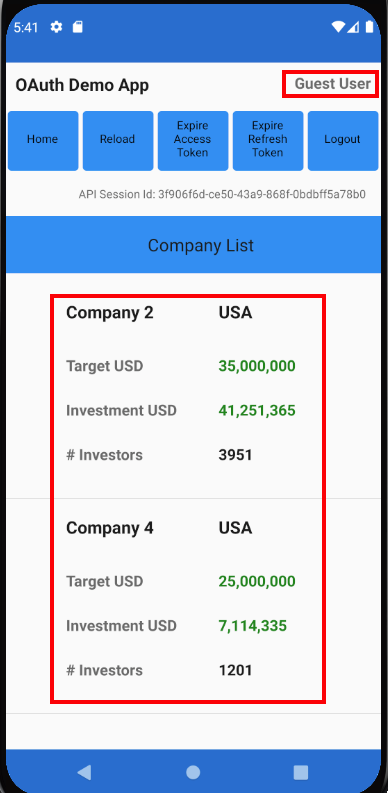
A ViewModelCoordinator class is used to wait for all views to load. In the event of any view receiving a permanent 401 response from the API, a single OAuth redirect is triggered by the main activity:
private fun handleErrorsAfterLoad() {
if (this.loadedCount == this.loadingCount) {
val errors = this.getLoadErrors()
val loginRequired = errors.find { e -> e.errorCode == ErrorCodes.loginRequired }
if (loginRequired != null) {
this.eventBus.post(LoginRequiredEvent())
return
}
val oauthConfigurationError = errors.find { e ->
(e.statusCode == 401 && e.errorCode == ErrorCodes.invalidToken) ||
(e.statusCode == 403 && e.errorCode == ErrorCodes.insufficientScope)
}
if (oauthConfigurationError != null) {
this.authenticator.clearLoginState()
}
}
}The ViewModelCoordinator class also deals with invalid token errors, such as incorrect scope, claims or audience configurations. For these errors, the app clears its login state to enable retries where the OAuth configuration has been fixed. The app then receives new tokens and the user can recover.
AppAuth Library – Login Requests
The authenticator implementation uses AppAuth Android classes to implement standards based OpenID Connect behaviour:
override fun startLogin(launchAction: (i: Intent) -> Unit) {
try {
val authService = AuthorizationService(this.applicationContext, this.getBrowserConfiguration())
this.loginAuthService = authService
val builder = AuthorizationRequest.Builder(
this.metadata!!,
this.configuration.clientId,
ResponseTypeValues.CODE,
Uri.parse(this.getLoginRedirectUri())
)
.setScope(this.configuration.scope)
val request = builder.build()
val authIntent = authService.getAuthorizationRequestIntent(request)
launchAction(authIntent)
} catch (ex: Throwable) {
throw ErrorFactory().fromLoginOperationError(ex, ErrorCodes.loginRequestFailed)
}
}At runtime the properties of AppAuth objects are set based on our OAuth configuration settings:
{
"app": {
"apiBaseUrl": "https://api.authsamples.com/investments"
},
"oauth": {
"authority": "https://cognito-idp.eu-west-2.amazonaws.com/eu-west-2_CuhLeqiE9",
"userInfoEndpoint": "https://login.authsamples.com/oauth2/userInfo",
"clientId": "2vshs4gidsbpnjmsprhh607ege",
"webBaseUrl": "https://authsamples.com",
"loginRedirectPath": "/apps/basicmobileapp/postlogin.html",
"postLogoutRedirectPath": "/apps/basicmobileapp/postlogout.html",
"scope": "openid profile email https://api.authsamples.com/investments",
"deepLinkBaseUrl": "https://mobile.authsamples.com",
"customLogoutEndpoint": "https://login.authsamples.com/logout"
}
}
AppAuth libraries produce outgoing Authorization Code Flow (PKCE) request messages and then handle incoming response messages:
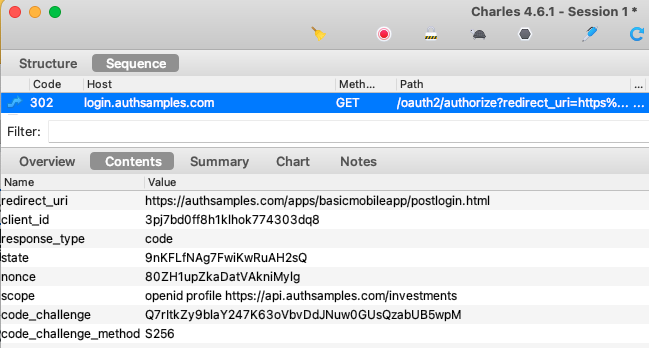
The libraries also select the type of login window, and the default option is to use a Chrome Custom Tab:
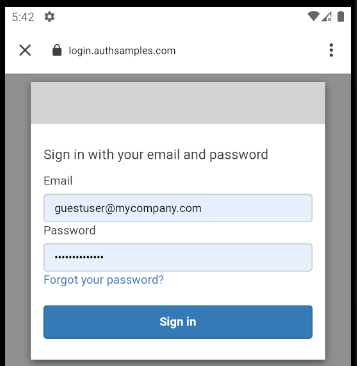
AppAuth Library – Login Responses
Our manifest file tells AppAuth’s login activity to use a Claimed HTTPS Scheme to receive login responses at the path provided:
<activity
android:name="net.openid.appauth.RedirectUriReceiverActivity"
android:exported="true">
<intent-filter android:autoVerify="true">
<action android:name="android.intent.action.VIEW" />
<category android:name="android.intent.category.DEFAULT"/>
<category android:name="android.intent.category.BROWSABLE"/>
<data
android:scheme="https"
android:host="mobile.authsamples.com"
android:path="/basicmobileapp/oauth/callback" />
</intent-filter>
</activity>Upon return from login we present the below Web Hosted Post Login Page in the Chrome Custom Tab window. This screen receives the authorization code in a response query parameter.
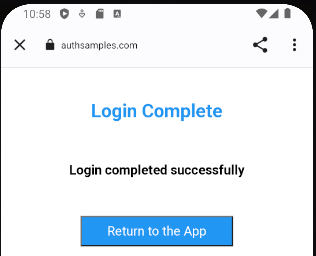
Javascript code in the web page invokes the login receiver activity when the continue button is pressed. This forwards any received query parameters, including the authorization code, to the app:
<script>
window.addEventListener('DOMContentLoaded', function() {
var redirectUri = 'https://mobile.authsamples.com/basicmobileapp/oauth/callback';
if (window.location.search) {
redirectUri += window.location.search;
}
if (window.location.hash) {
redirectUri += window.location.hash;
}
document.getElementById('continueButton').onclick = () => {
window.location.href = redirectUri;
};
});
</script>AppAuth Library – Cancelled Logins
It is possible for users to cancel logins if they are having trouble logging in, via the top left button:
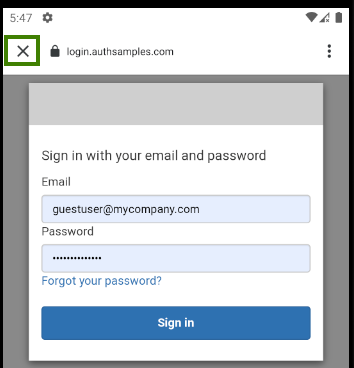
AppAuth libraries are well designed and provide error codes that we can use to determine cancellation and other conditions:
override suspend fun finishLogin(intent: Intent) {
val authorizationResponse = AuthorizationResponse.fromIntent(intent)
val ex = AuthorizationException.fromIntent(intent)
this.loginAuthService?.dispose()
this.loginAuthService = null
when {
ex != null -> {
if (ex.type == AuthorizationException.TYPE_GENERAL_ERROR &&
ex.code == AuthorizationException.GeneralErrors.USER_CANCELED_AUTH_FLOW.code
) {
throw ErrorFactory().fromRedirectCancelled()
}
throw ErrorFactory().fromLoginOperationError(ex, ErrorCodes.loginResponseFailed)
}
authorizationResponse != null -> {
this.exchangeAuthorizationCode(authorizationResponse)
}
}
}For cancelled logins we return the user to the Login Required view so that they can retry the operation:
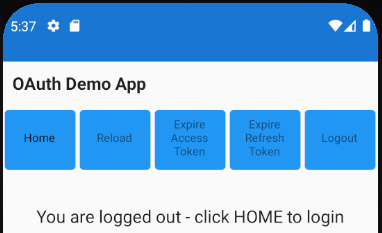
AppAuth Library – Authorization Code Grant
After successfully receiving the login response, the Authorization Code Flow continues by swapping the received code for tokens:
private suspend fun exchangeAuthorizationCode(authResponse: AuthorizationResponse) {
return suspendCoroutine { continuation ->
val callback =
AuthorizationService.TokenResponseCallback { tokenResponse, ex ->
when {
ex != null -> {
val error = ErrorFactory().fromTokenError(ex, ErrorCodes.authorizationCodeGrantFailed)
continuation.resumeWithException(error)
}
tokenResponse == null -> {
val empty = RuntimeException("Authorization code grant returned an empty response")
continuation.resumeWithException(empty)
}
else -> {
this.saveTokens(tokenResponse)
continuation.resume(Unit)
}
}
}
val tokenRequest = authResponse.createTokenExchangeRequest()
val authService = AuthorizationService(this.applicationContext)
authService.performTokenRequest(tokenRequest, NoClientAuthentication.INSTANCE, callback)
}
}The message sent includes a verifier used for PKCE handling, and AppAuth libraries take care of supplying this correctly.
Secure Token Storage
After login, the app stores OAuth tokens using a TokenStorage class, which saves them to shared preferences. The Android system ensures that no other app can access the demo app’s tokens, so it is not necessary to encrypt the stored values.
Application Restarts without Login
When the app starts, it loads OpenID Connect metadata and also any tokens that have been saved to Android storage. This prevents the user needing to re-authenticate on every application restart:
override suspend fun initialize() {
this.getMetadata()
this.tokenStorage.loadTokens()
}AppAuth Library – Refreshing Access Tokens
AppAuth classes are also used to send a Refresh Token Grant message, via the TokenRequest class. The AppAuth error codes allow us to reliably detect the ‘Invalid Grant‘ response when the refresh token finally expires:
private suspend fun performRefreshTokenGrant() {
val refreshToken = this.tokenStorage.loadTokens()?.refreshToken
if (refreshToken.isNullOrBlank()) {
return
}
this.getMetadata()
return suspendCoroutine { continuation ->
val callback =
AuthorizationService.TokenResponseCallback { tokenResponse, ex ->
when {
ex != null -> {
if (ex.type == AuthorizationException.TYPE_OAUTH_TOKEN_ERROR &&
ex.code == AuthorizationException.TokenRequestErrors.INVALID_GRANT.code
) {
this.tokenStorage.removeTokens()
continuation.resume(Unit)
this.concurrencyHandler.resume()
} else {
val error = ErrorFactory().fromTokenError(ex, ErrorCodes.tokenRenewalError)
continuation.resumeWithException(error)
this.concurrencyHandler.resumeWithException(error)
}
}
tokenResponse == null -> {
val error = RuntimeException("Refresh token grant returned an empty response")
continuation.resumeWithException(error)
this.concurrencyHandler.resumeWithException(error)
}
else -> {
this.saveTokens(tokenResponse)
continuation.resume(Unit)
this.concurrencyHandler.resume()
}
}
}
val tokenRequest = TokenRequest.Builder(
this.metadata!!,
this.configuration.clientId
)
.setGrantType(GrantTypeValues.REFRESH_TOKEN)
.setRefreshToken(refreshToken)
.build()
val authService = AuthorizationService(this.applicationContext)
authService.performTokenRequest(tokenRequest, callback)
}
}Token Renewal and Concurrency
When multiple fragments call APIs and receive 401 responses, the token renewal call should be synchronised so that it only occurs once. If we view HTTP traffic we can see the correct behaviour:
- Initially two fragments call the API and receive a 401 response
- A single token renewal message is sent to the authorization server
- Both fragments successfully call the API again with the new token
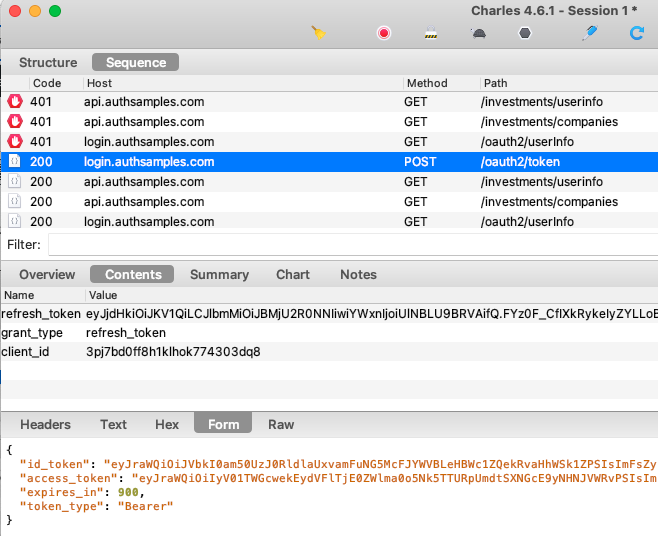
To ensure this, our code uses a ConcurrentActionHandler class, so that only a single UI fragment does a token refresh at a time:
override suspend fun synchronizedRefreshAccessToken(): String {
val refreshToken = this.tokenStorage.loadTokens()?.refreshToken
if (!refreshToken.isNullOrBlank()) {
this.concurrencyHandler.execute(this::performRefreshTokenGrant)
val accessToken = this.tokenStorage.loadTokens()?.accessToken
if (!accessToken.isNullOrBlank()) {
return accessToken
}
}
throw ErrorFactory().fromLoginRequired()
}As well as being more efficient, this ensures that our code uses refresh token rotation reliably, as opposed to receiving multiple refresh tokens and possibly saving one that has been invalidated.
Logout
The app’s logout logic involves these two actions:
- Removing the refresh token from Android secure storage
- Removing the authorization server’s session cookie
The second step requires a redirect on a Chrome Custom Tab, since the authorization server session cookie can only be removed via the system browser. To make this work with AWS Cognito’s custom logout endpoint, the following code was used:
override fun startLogout(launchAction: (i: Intent) -> Unit) {
val tokens = this.tokenStorage.loadTokens()
val idToken = tokens?.idToken
this.tokenStorage.removeTokens()
try {
if (idToken == null) {
val message = "Logout is not possible because tokens have already been removed"
throw IllegalStateException(message)
}
val logoutUrlBuilder = this.createLogoutUrlBuilder()
val logoutUrl = logoutUrlBuilder.getEndSessionRequestUrl(
this.metadata!!,
this.getPostLogoutRedirectUri(),
idToken
)
launchAction(this.getLogoutIntent(logoutUrl))
} catch (ex: Throwable) {
throw ErrorFactory().fromLogoutOperationError(ex)
}
}Logout request messages include a Post Logout Return Location that points to our Web Hosted Post Logout Page:
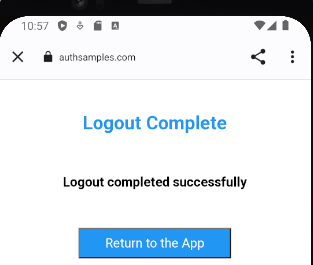
When continue is clicked, the web page again invokes the app’s Claimed HTTPS Scheme, which matches the below logout receiver activity, so that control is returned to the app and logout can complete:
<activity
android:name=".plumbing.oauth.logout.LogoutRedirectUriReceiverActivity"
android:exported="true">
<intent-filter android:autoVerify="true">
<action android:name="android.intent.action.VIEW" />
<category android:name="android.intent.category.DEFAULT"/>
<category android:name="android.intent.category.BROWSABLE"/>
<data
android:scheme="https"
android:host="mobile.authsamples.com"
android:path="/basicmobileapp/oauth/logoutcallback" />
</intent-filter>
</activity>AppAuth Library – Error Codes
The Error Category and Code from the AppAuth Errors Enumeration can be useful if you need to better understand any AppAuth error codes reported by the app:
/**
* Error codes related to failed token requests.
*
* @see "The OAuth 2.0 Authorization Framework" (RFC 6749), Section 5.2
* <https://tools.ietf.org/html/rfc6749#section-5.2>"
*/
public static final class TokenRequestErrors {
// codes in this group should be between 2000-2999
/**
* An `invalid_request` OAuth2 error response.
*/
public static final AuthorizationException INVALID_REQUEST =
tokenEx(2000, "invalid_request");
/**
* An `invalid_client` OAuth2 error response.
*/
public static final AuthorizationException INVALID_CLIENT =
tokenEx(2001, "invalid_client");
/**
* An `invalid_grant` OAuth2 error response.
*/
public static final AuthorizationException INVALID_GRANT =
tokenEx(2002, "invalid_grant");
}The app’s error handling is diligent about capturing these runtime details, to help with OAuth problem resolution:
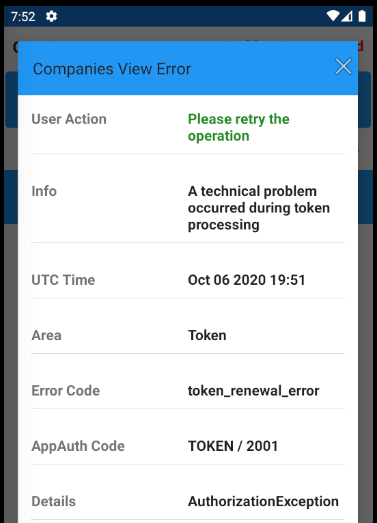
By coding in Kotlin, our Android sample requires fewest technical layers to integrate AppAuth libraries, and we have first-class access to error details.
Deep Linking
Our Android app can also use deep linking. An additional forwarding activity is used, to control whether deep links are allowed to execute. The app ignores deep links when a Chrome Custom Tab window is top most:
private fun handleIntent(receivedIntent: Intent) {
if (!this.app().isMainActivityTopMost()) {
finish()
return
}
receivedIntent.setClass(this, MainActivity::class.java)
receivedIntent.addFlags(Intent.FLAG_ACTIVITY_CLEAR_TOP or Intent.FLAG_ACTIVITY_SINGLE_TOP)
startActivity(receivedIntent)
}It is possible to deep link to an unauthorized or invalid API resource, resulting in the API returning an error. Our transactions view model deals with this reliably, by processing API error codes:
private fun isForbiddenError(error: UIError): Boolean {
if (error.statusCode == 404 && error.errorCode.equals(ErrorCodes.companyNotFound)) {
return true
} else if (error.statusCode == 400 && error.errorCode.equals(ErrorCodes.invalidCompanyId)) {
return true
}
return false
}Debugging Kotlin Code
The app can be debugged via the below toolbar icon, to step through code using commands from the Run Menu. This also enables us to view the state of AppAuth classes, when we need to troubleshoot OAuth code:
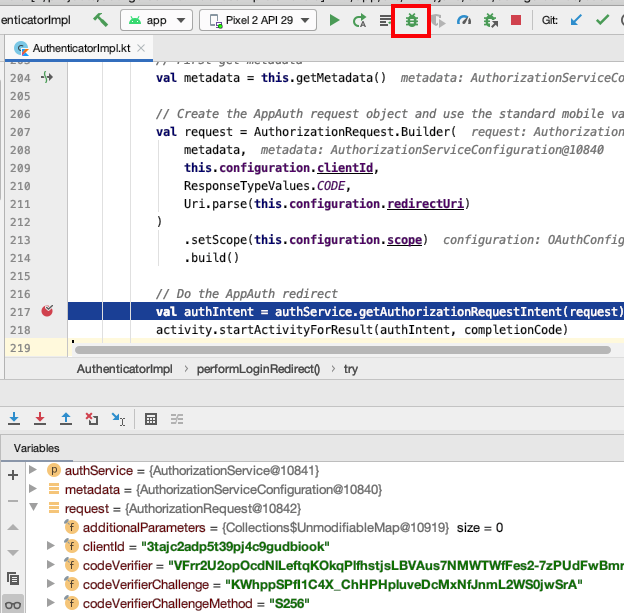
Code Quality Checks
We use the detekt static analyzer tool, to check some of the finer details of our Kotlin code. A detekt.gradle file was added to the project, after which the following command can be run:
./gradlew detekt
This produces warnings that help to keep the code base maintainable:
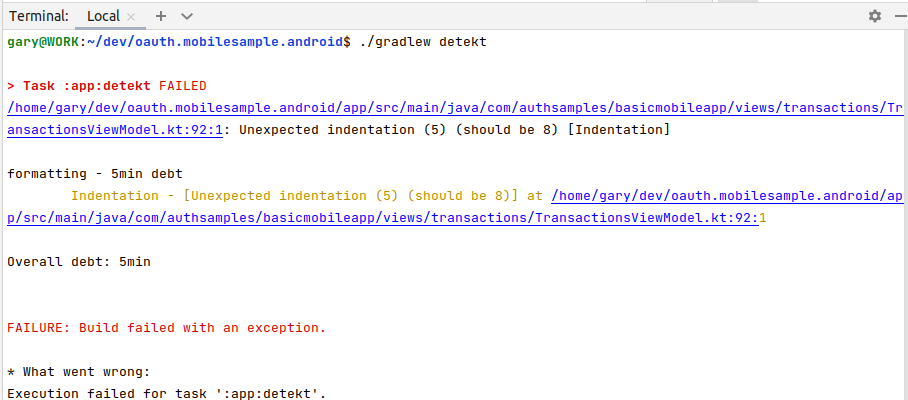
AppAuth Libraries
This blog demonstrates mobile integration using the recommendations from RFC8252. Doing so does not mandate use of the AppAuth libraries though. If you run into any library blocking issues, the code flow could be implemented fairly easily in the AuthenticatorImpl class.
Where Are We?
We have implemented an OpenID Connect secured Android App with no blocking issues. By using native tech a software company would now be in a strong technical position:
- The app supports many possible types of user login
- The app has a modern coding model that is easy to extend
- The app can use the latest Android native features
- The app has good reliability and error handling control
Next Steps
- Next we will start describing our Secured iOS App’s Behaviour
- For a list of all blog posts see the Index Page